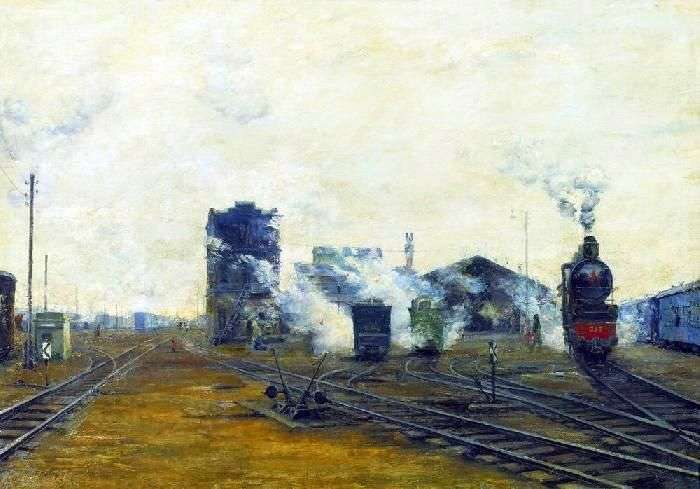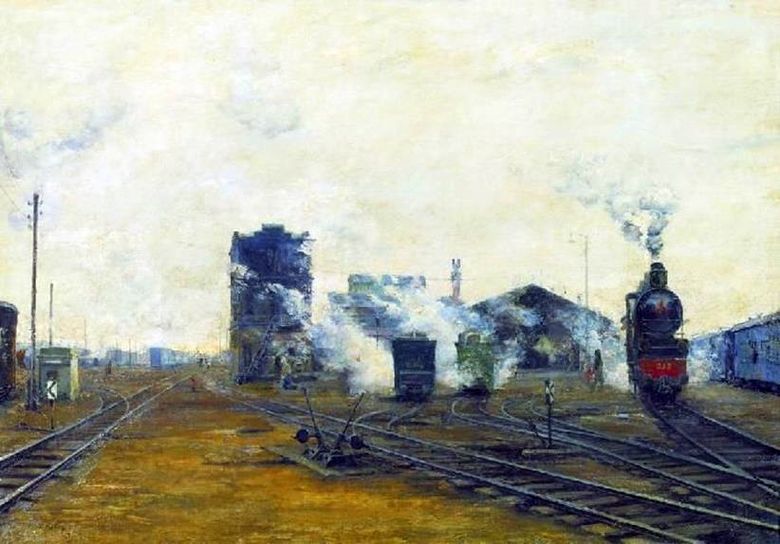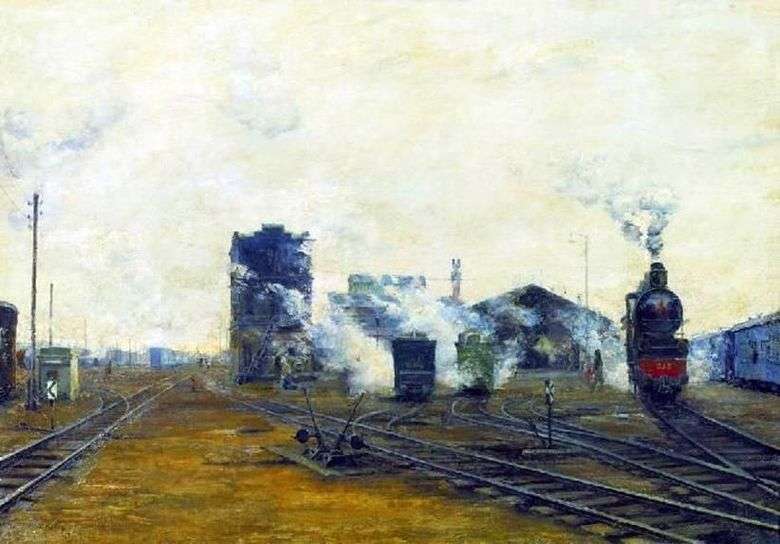
In 1923, the artist painted the painting “Transport is getting better”, which was included in the gold fund of Soviet art. The canvas organically combined the traditions of the Russian realistic landscape, perceived by Yakovlev from his teachers in the School of Painting, Sculpture and Architecture, and new searches for young Soviet art. It was a genuinely groundbreaking work on its theme devoted to the restoration of the national economy, and in its life’s truthfulness and persuasiveness, and in its vivid imagery.
Yakovlev’s work asserted the legitimacy and necessity of the existence of a landscape painting in Soviet painting, asserted the possibility of expressing in it the great idea of the socialist reorganization of the Soviet land, of pride in a young republic that had defended its existence in the fire of civil war and started peaceful work. The artist painted a modest railway station at an early hour. The smoke of locomotives, the hurrying figures of people, all indicate that after years of inactivity, it revived.
Yakovlev writes the prospect of the railway lines and power transmission poles escaping into the distance, which allows him to create a sense of spaciousness. These rails leaving the horizon, station buildings and depots standing under steam locomotives symbolize the labor life of the first years of the recovery period. The painting is characterized by great modesty and simplicity in compositional and coloristic relations. But in it there is something that was not in the earlier works of the artist-a sense of the new in life that determined the clarity of the image, the slenderness and rigor of a formal solution that perfectly fit the ideological content of the picture that speaks of a revitalized life in Soviet Russia, of inexhaustible creative opportunities for free Soviet people.
It seems that the artist deliberately restricts himself so as not to miss the main thing, not to disturb the mood of calm confidence and concentration that reigns in the picture. “Transport is adjusted” distinguishes the creative, excited attitude of the artist from reality from many previous and contemporary works on an industrial theme. That is why this picture is imbued with genuine poetry, which is why a simple, nothing, in fact, unremarkable motive acquired such power and expressiveness under the brush of Yakovlev.
This picture is one of the bright paintings in the Soviet art of the 1920s. The artist managed to create in it a typical, generalizing image, imbued with a deep social content. Probably, it is good, when in a breakage the transport is adjusted. Boris Nikolaevich Yakovlev, who, after graduating from the Physics and Mathematics Faculty of Moscow University, received a decent art education under the leadership of AM Vasnetsov, NA Kasatkin, AE Arkhipov, and SV Malyutin in the School of Painting, Sculpture and Architecture, responded to such a positive process in the country with his painting. The theme of the industrial landscape will be popular in Soviet art. BN Yakovlev also contributed to it, and not only with a balanced canvas, which inspires calm confidence that the matter will work.
There will be other similar paintings, although, apparently, with great pleasure the artist wrote traditional landscapes and still lifes, often performed in the Vangoge manner with a solid amount of colors on the canvas. Yakovlev, Boris Nikolayevich [5 .9. 1890, Moscow, – 8.12.1972, ibid.], Soviet painter, People’s Artist of the RSFSR, Corresponding Member of the Academy of Arts of the USSR. Member of the CPSU since 1960. He studied at the Moscow School of Painting, Sculpture and Architecture in A. M. Vasnetsov and A. S. Stepanov. Member of AHRR. He taught at VGIKS. The founder of the Soviet industrial landscape. The work of Ya. Differs in a wide manner of writing, pasty texture.
 Les transports s’améliorent – Boris Yakovlev
Les transports s’améliorent – Boris Yakovlev El transporte está mejorando – Boris Yakovlev
El transporte está mejorando – Boris Yakovlev Feels sick by Vasily Meshkov
Feels sick by Vasily Meshkov Evening shadows by Leonard Turzhansky
Evening shadows by Leonard Turzhansky Zemskaya school in Moscow Russia by Boris Kustodiev
Zemskaya school in Moscow Russia by Boris Kustodiev Early Spring by Konstantin Korovin
Early Spring by Konstantin Korovin Bolshevik by Boris Kustodiev
Bolshevik by Boris Kustodiev New tale by Nikolay Bogdanov-Belsky
New tale by Nikolay Bogdanov-Belsky